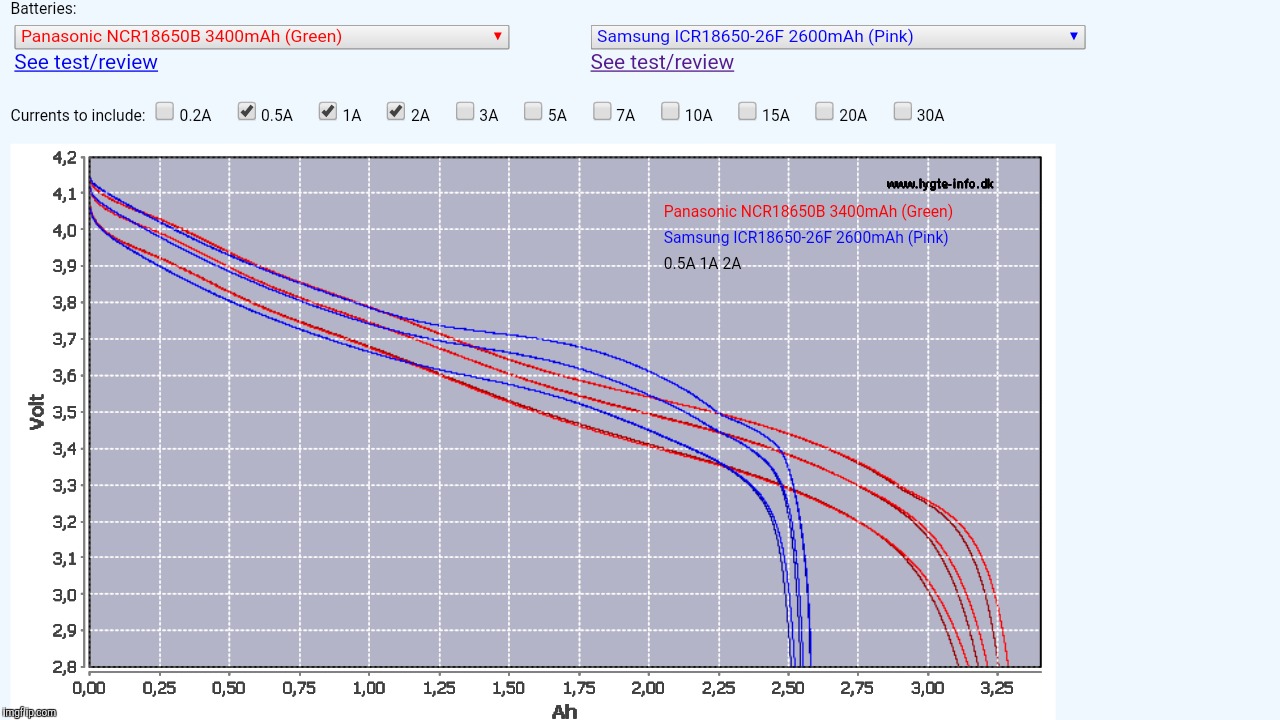Protection affects all cells in the same way, i.e. it won’t change the ranking (provided the same protection circuit is used).
i was wondering why are there gold plated and non(plain silver) negative terminals? is there any difference? these are both originals right?’
thank you
That would be the colour of the protection board's contact, not the battery itself.
There are different protection boards, some better than others.
thank you for the clarification.
Generally a gold plated board means it is a better quality circuit and most likely seiko. Most cheap protected cells I’ve seen don’t have gold plated contacts.
Hi, I’m using 2 of these protected green batteries to power a Nitecore EC4SW.
I’m wondering if there would be a noticeable difference between these vs more expensive protected NCR18650B based cells from EVVA, KeepPower, Orbtronic, etc.
Or if there are other batteries better suited to maximize safety, runtime, or output in the EC4SW.
Specific make/model info would be appreciated.
Thanks for sharing your knowledge.
No, you wouldnt have any noticable difference.
You could try something like: Samsung INR18650-30Q or LG HG2…
I have a feeling this battery will continue to live in for long time it’s a classic. Most edc lights are 3amps and under anyways. They work great in my powerbank. GB has them on sale from to time. The price isn’t always the same from the listing until you click to open the page. The ones I got I played $27 for 8.
Nive review.
Is it OK to replace Samsung ICR18650-26F 2600mAh included in the OEM Laptop battery with the more powerful Panasonic NCR18650B 3400mAh
I’m worried both batteries have different power output and might cause any problems with the laptop.
ICR18650-26F 2600mAh Specs:
NCR18650B 3400mAh Specs:
Test/Review of Samsung ICR18650-26F 2600mAh (Pink) [NCR18650B]
I like the color of it.
How long is it used?
Has anyone tried those cells in a high current drain flashlight?
They are only rated at:
Discharge_Current_max = 6.5A
What will happen if you stress them?
After what time and at which current will it happen?
(they will probably catch fire and explode…?)
I tried a half-discharged 18650B in Emisar D4 with 219c. Worked OK for a couple of minutes, then I got bored. I think there was a thermal stepdown.
What was the discharge current?
See the graphs and read the text in the OP.
It’s not a high drain cell at all, so you don’t use it for high drain appliances.
It’s a great battery up to 3 Amperes, but with the high internal resistance you get too much voltage sag when you draw more current from it. The losses are translated into heat = the battery will get warm.
Haven’t measured. And I don’t have the hardware to measure it really.
Kinetic:

As you can see in this graph I've obtained from HKJ's comparator, at typical laptop discharge currents the Panasonic NCR18650B should give you some advantage, but can't say for sure how much will it be as it depends on the particular battery controller IC of the laptop and the OS. As smartphones and tablets, the computer will start to moan low battery before the stuff hits an average of ≈3.4V per cell under a typical load. I am pretty sure it'll need at least one or two full charge and discharge cycles before the thing will start to see the additional available capacity, if able it is. There's no guarantee this will happen as I don't know if the battery IC will reprogram itself to the particular shape and extra available energy the NCR18650B provides at lower voltages.
I'd be far more confident doing the overhaul with Samsung ICR18650-30B cells. These won't provide you with any extra capacity as they need 4.35V for it to happen, this however means they'll enjoy much more cycles in the stressful environment of a laptop (high voltage). See: BU-808: How to Prolong Lithium-based Batteries

It’s a great battery up to 3 Amperes, but with the high internal resistance you get too much voltage sag when you draw more current from it. The losses are translated into heat = the battery will get warm.
I know that this cell is not really suited for high current applications. (it’s rated 6,5A max.)
But I have 100 pcs here, that somehow want to be used. (I have to desolder them first from a battery pack, that was never used…)
My interest was in: which currents are still safe, so that this cell won’t burn or explode…
(specs are one thing, but panasonic is know to have a good quality, so I guess there is some safety range… )
For sustained usage, I think that more headroom is better. Maybe 50%? So for a battery rated/tested for 6.5A continuous, I’d feel comfortable using it in something that draws ~3A.
thank you for your sharing